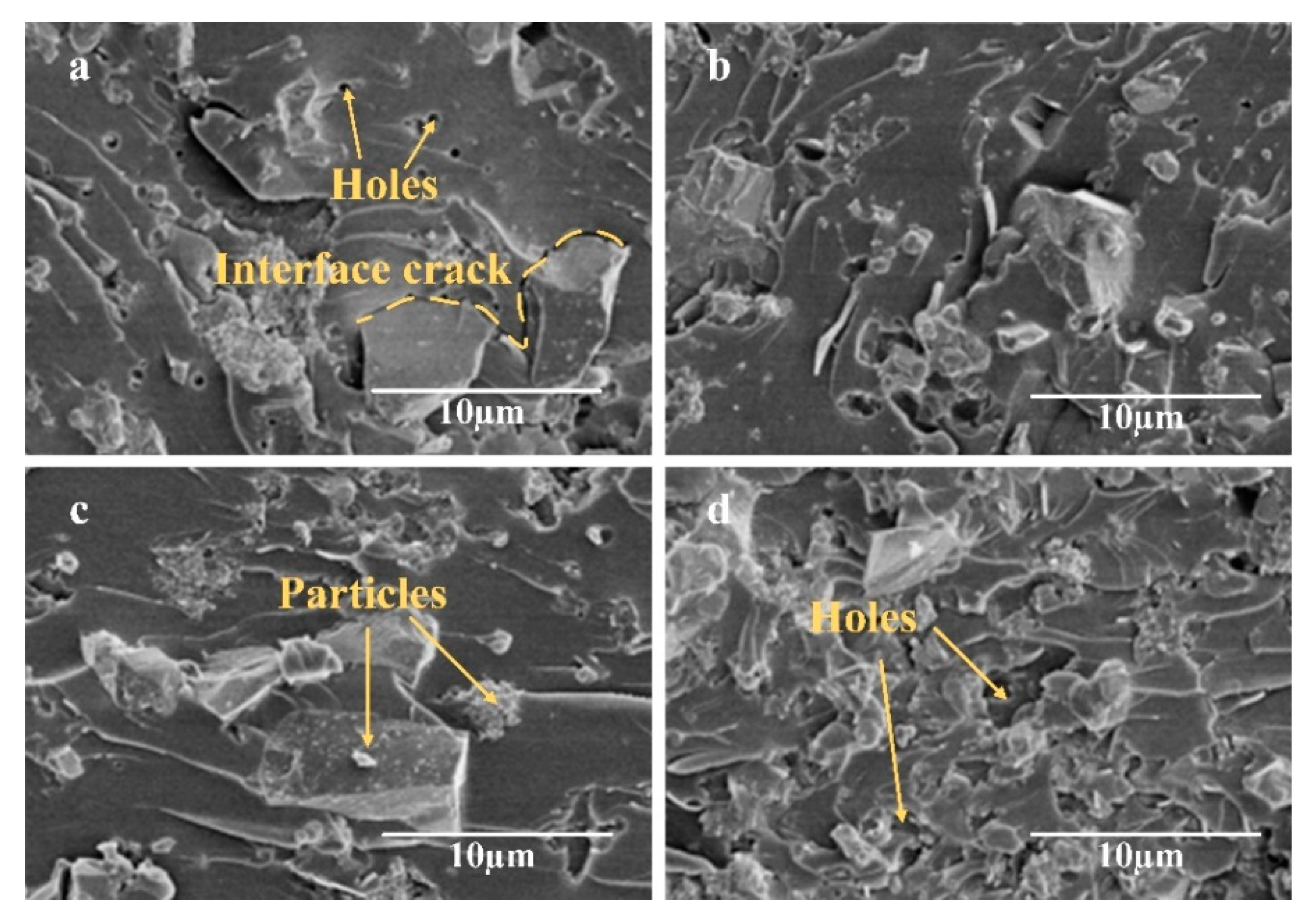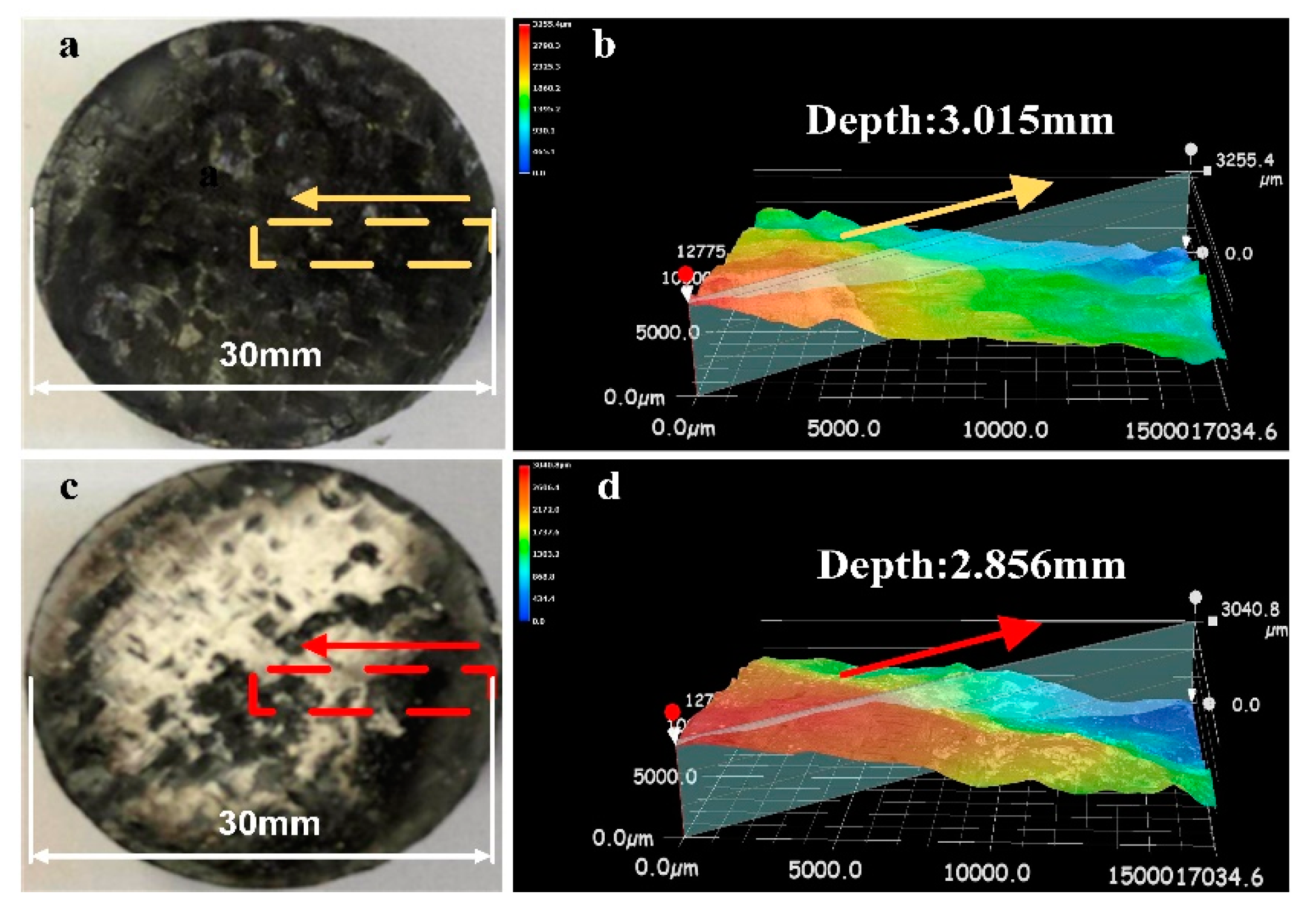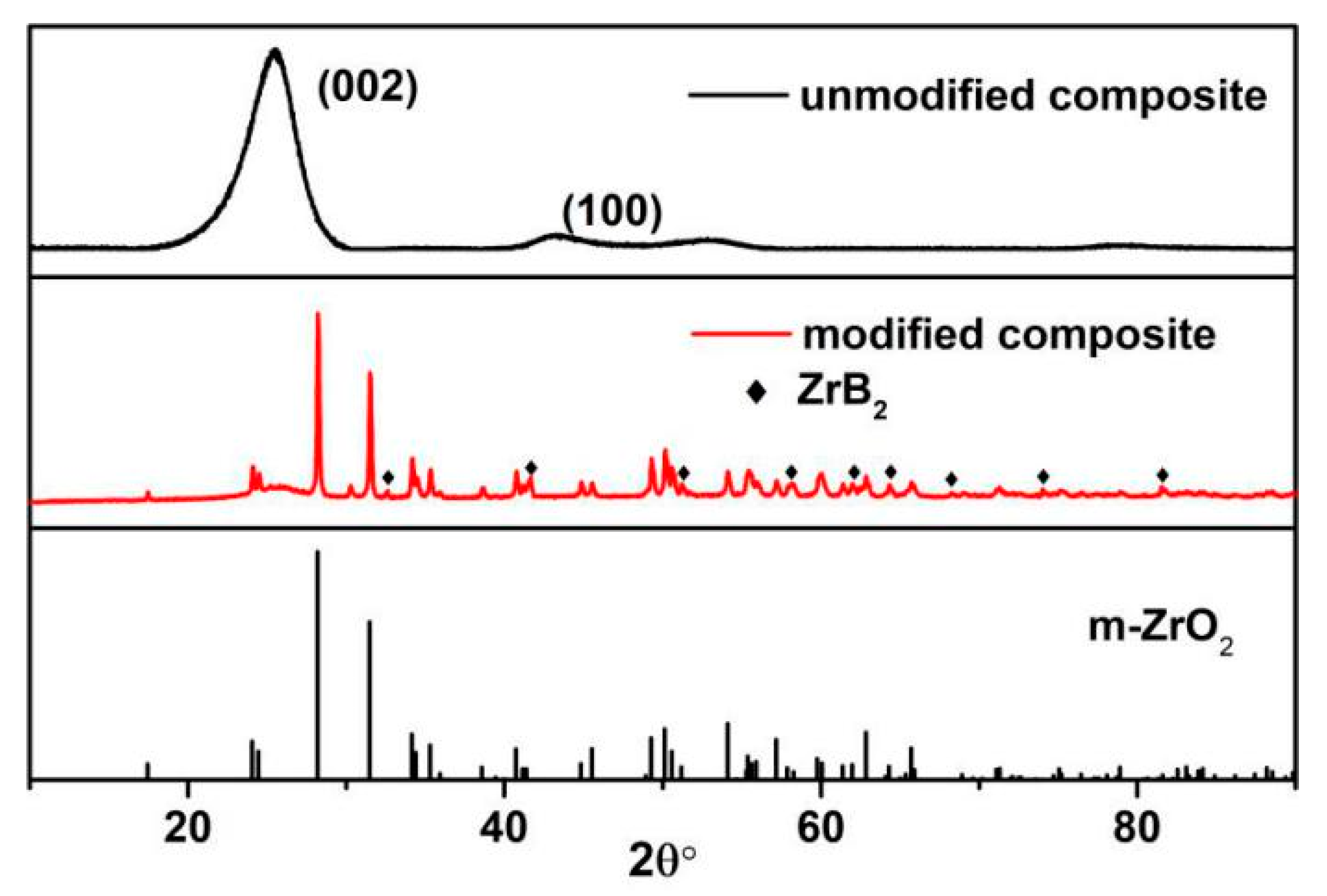Ablation Behavior of a Carbon Fabric Reinforced Phenolic Composite Modified by Surface-Decorated ZrB2/SiC
Abstract
:1. Introduction
2. Materials and Methods
2.1. Materials
2.2. Preparation of Surface-Decorated ZrB2–SiC-Modified Phenolic Composites
2.3. Preparation of Surface-Decorated ZrB2–SiC-Modified C–Ph Composites
2.4. Characterization
3. Results and Discussion
3.1. Surface Decoration of ZrB2–SiC Particles
3.2. Mechanical Property of the Surface-Decorated ZrB2–SiC-Modified Phenolic Composite
3.3. Ablation Behavior of the Surface-Decorated ZrB2–SiC-Modified C–Ph Composite
3.4. Ablation Mechanism of the Surface-Decorated ZrB2–SiC-Modified C–Ph Composite
4. Conclusions
Author Contributions
Funding
Conflicts of Interest
References
- Tang, S.F.; Hu, C.L. Design, Preparation and Properties of Carbon Fiber Reinforced Ultra-High Temperature Ceramic Composites for Aerospace Applications: A Review. J. Mater. Sci. Technol. 2017, 33, 117–130. [Google Scholar] [CrossRef]
- Natali, M.; Kenny, J.M.; Torre, L. Science and technology of polymeric ablative materials for thermal protection systems and propulsion devices: A review. Prog. Mater. Sci. 2016, 84, 192–275. [Google Scholar] [CrossRef]
- Ma, Y.Y.; Yang, Y.; Lu, C.X.; Wen, X.; Liu, X.; Lu, K.; Wu, S.; Liu, Q. Extraordinary improvement of ablation resistance of carbon/phenolic composites reinforced with low loading of graphene oxide. Compos. Sci. Technol. 2018, 167, 53–61. [Google Scholar] [CrossRef]
- Rivier, M.; Lachaud, J.; Congedo, P.M. Ablative thermal protection system under uncertainties including pyrolysis gas composition. Aerosp. Sci. Technol. 2019, 84, 1059–1069. [Google Scholar] [CrossRef] [Green Version]
- Park, J.K.; Cho, D.; Kang, T.J. Acomparison of the interfacial, thermal and ablative properties between spun and filament yarn type carbon fabric/phenolic composites. Carbon 2004, 42, 795–804. [Google Scholar] [CrossRef]
- Amirsardari, Z.; Aghdam, R.M.; Niasari, M.S.; Jahannama, M.R. Influence of ZrB2 Nanoparticles on the Mechanical and Thermal Behaviors of Carbon Nanotube Reinforced Resol Composite. J. Mater. Sci. Technol. 2016, 32, 611–616. [Google Scholar] [CrossRef]
- Srikanth, I.; Padmavathi, N.; Kumar, S.; Ghosal, P.; Kumar, A.; Subrahmanyam, C. Mechanical, thermal and ablative properties of zirconia, CNT modified carbon/phenolic composites. Compos. Sci. Technol. 2013, 80, 1–7. [Google Scholar] [CrossRef]
- Eslami, Z.; Yazdani, F.; Mirzapour, M.A. Thermal and mechanical properties of phenolic-based composites reinforced by carbon fibers and multiwall carbon nanotubes. Compos. Part. A-Appl. Sci. Manuf. 2015, 72, 22–31. [Google Scholar] [CrossRef]
- Ma, C.; Ma, Z.; Gao, L.H.; Wu, T.; Wang, F.; Ishida, H. Zirconium carbide-modified polymer-matrix composites with improved reflectivity under high-energy laser ablation. Ceram. Int. 2019, 45, 17681–17687. [Google Scholar] [CrossRef]
- Ding, J.; Huang, Z.; Qin, Y.; Shi, M.; Huang, C.; Mao, J. Improved ablation resistance of carbon–phenolic composites by introducing zirconium silicide particles. Compos. B Eng. 2015, 82, 100–107. [Google Scholar] [CrossRef]
- George, P.; Cristina, E.P.; Adriana, S.; Dincă, I.; Ficai, A.; Andronescu, E.; Truşcă, R. Influence of nanometric silicon carbide on phenolic resin composites properties. Bull. Mater. Sci. 2016, 39, 769–775. [Google Scholar]
- Chen, X.Y.; Chen, P.; Hong, C.Q. Improved ablation resistance of carbon–phenolic composites by introducing zirconium diboride particles. Compos. B Eng. 2013, 47, 320–325. [Google Scholar] [CrossRef]
- Huang, D.; Zhang, M.Y.; Huang, Q.Z.; Wang, L.; Tong, K. Mechanical Property, Oxidation and Ablation Resistance of C/C–ZrB2–ZrC–SiC Composite Fabricated by Polymer Infiltration and Pyrolysis with Preform of Cf/ZrB2. J. Mater. Sci. Technol. 2016, 33, 481–486. [Google Scholar] [CrossRef]
- Zhang, D.Y.; Hu, P.; Dong, S. Oxidation behavior and ablation mechanism of Cf/ZrB2-SiC composite fabricated by vibration-assisted slurry impregnation combined with low-temperature hot pressing. Corros. Sci. 2019, 161, 108181. [Google Scholar] [CrossRef]
- Aliasgarian, R.; Seyyed, M.N.; Mirsalehi, E. Ablation mechanism of ZrB2-SiC coating for SiC-coated graphite under an oxyacetylene flame. Surf. Coat. Technol. 2018, 350, 511–518. [Google Scholar] [CrossRef]
- Zhao, X.; Wang, Y.G.; Duan, L.Y. Improved ablation resistance of C/SiC-ZrB2 composites via polymer precursor impregnation and pyrolysis. Ceram. Int. 2017, 43, 12480–12489. [Google Scholar] [CrossRef]
- Xu, Y.L.; Sun, W.; Xiong, X. Ablation characteristics of mosaic structure ZrC-SiC coatings on low-density, porous C/C composites. J. Mater. Sci. Technol. 2019, 35, 2785–2798. [Google Scholar] [CrossRef]
- Xia, X.; Jiang, W.H.; Chen, T.; Liu, J.; Miao, L.; Zhang, X. Preparation of C@ZrSiO4 Inclusion Pigment using Compound Colorants via Non-hydrolytic Sol-gel Method. Adv. Mater. 2014, 936, 170–175. [Google Scholar]
- Xie, D.J.; Xu, J.; Cheng, H.F.; Wang, N.; Zhou, Q. The role played by amine and ethyl group in the reversible thermochromic process of [(C2H5)2NH2]2CuCl4 probing by FTIR and 2D-COS analysis. J. Mol. Struct. 2018, 1161, 267–272. [Google Scholar] [CrossRef]
- Ovchinnikov, O.V.; Evtukhova, A.V.; Kondratenko, T.S.; Smirnov, M.S.; Khokhlov, V.Y.; Erina, O.V. Manifestation of intermolecular interactions in FTIR spectra of methylene blue molecules. Vib. Spectrosc. 2016, 86, 181–189. [Google Scholar] [CrossRef]
- Yuan, H.; Wang, C.G.; Zhang, S. Effect of surface modification on carbon fiber and its reinforced phenolic matrix composite. Appl. Surf. Sci. 2012, 259, 288–293. [Google Scholar] [CrossRef]
- Ma, C.; Ma, Z.; Gao, L.H.; Liu, Y.; Wu, T.; Wang, F.; Ishida, H. Ablation behavior of boron-modified phenolic resin irradiated by high-energy continuous-wave laser and its evolution of carbon structure. Mater. Des. 2019, 180, 107954. [Google Scholar] [CrossRef]
- Xu, F.; Zhu, S.Z.; Ma, Z.; Li, H.; Wang, J.; Wu, T.; Wang, F. Ablation behavior of inorganic particle-filled polybenzoxazine composite coating irradiated by high-intensity continuous laser. Ceram. Int. 2019, 45, 14968–14975. [Google Scholar] [CrossRef]
- Zhao, M.; Song, H.H. Catalytic Graphitization of Phenolic Resin. J. Mater. Sci. Technol. 2011, 27, 266–270. [Google Scholar] [CrossRef]
- Han, J.C.; He, X.D.; Du, S.Y. Oxidation and ablation of 3D carbon-carbon composite at up to 3000 °C. Carbon 1995, 33, 473–478. [Google Scholar] [CrossRef]
- Cheon, J.H.; Shin, E.S. Assessment of the ablation characteristics of carbon /phenolic composites using X-ray microtomography. Compos. Sci. Technol. 2019, 182, 107740. [Google Scholar] [CrossRef]







| Sample | APS/mL | H2O/mL | Ethanol/mL | ZrB2–SiC/g | ZrB2–SiC/Phenolic Mass Ratio |
|---|---|---|---|---|---|
| B1 | 0 | 0 | 0 | 20 | 1:4 |
| C1 | 12 | 8 | 80 | 20 | 1:4 |
| C2 | 12 | 8 | 80 | 20 | 1:3 |
| C3 | 12 | 8 | 80 | 20 | 1:2 |
| Sample | ZrB2–SiC/Phenolic Mass Ratio | Phenolic/Carbon Fabric Volume Ratio |
|---|---|---|
| Unmodified Composite | 0 | 1:1 |
| 1B-C–Ph | 1:4 | 1:1 |
| 1C-C–Ph | 1:4 | 1:1 |
| 2C-C–Ph | 1:3 | 1:1 |
| Sample | ZrB2-SiC/Phenolic Volume Ratio | Bending Strength/MPa |
|---|---|---|
| B1 | 1:4 | |
| C1 | 1:4 | |
| C2 | 1:3 | |
| C3 | 1:2 |
| Sample | Mass Ablation Ratio/(10−2 g·s−1) |
|---|---|
| Unmodified Composite | 4.61 |
| 1B-C–Ph | 3.88 |
| 1C-C–Ph | 3.87 |
| 2C-C–Ph | 3.46 |
© 2020 by the authors. Licensee MDPI, Basel, Switzerland. This article is an open access article distributed under the terms and conditions of the Creative Commons Attribution (CC BY) license (http://creativecommons.org/licenses/by/4.0/).
Share and Cite
Xu, F.; Zhu, S.; Hu, J.; Ma, Z.; Liu, Y. Ablation Behavior of a Carbon Fabric Reinforced Phenolic Composite Modified by Surface-Decorated ZrB2/SiC. Materials 2020, 13, 256. https://doi.org/10.3390/ma13020256
Xu F, Zhu S, Hu J, Ma Z, Liu Y. Ablation Behavior of a Carbon Fabric Reinforced Phenolic Composite Modified by Surface-Decorated ZrB2/SiC. Materials. 2020; 13(2):256. https://doi.org/10.3390/ma13020256
Chicago/Turabian StyleXu, Feng, Shizhen Zhu, Jingdan Hu, Zhuang Ma, and Yanbo Liu. 2020. "Ablation Behavior of a Carbon Fabric Reinforced Phenolic Composite Modified by Surface-Decorated ZrB2/SiC" Materials 13, no. 2: 256. https://doi.org/10.3390/ma13020256




